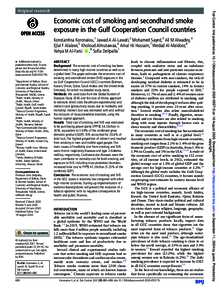وثيقة
Economic cost of smoking and secondhand smoke exposure in the Gulf cooperation council countries.
المعرف
DOI: 10.1136/tobaccocontrol-2020-055715
المصدر
Tobacco Control. v. 30, 6, p. 680-686
المساهمون
Al-Lawati, Jawad A., مؤلف
Sayed, Mohamed., مؤلف
Al-Wadey, Ali M., مؤلف
Al-Alawi, Ejlal F., مؤلف
Almutawaa, Kholoud., مؤلف
Hussain, Amal H. J. , مؤلف
Al-Maidoor, Wedad., مؤلف
Al-Farsi, Yahya M., مؤلف
Delipalla, Sofia., مؤلف
الدولة
United Kingdom.
الناشر
BMJ Publishing Group.
ميلادي
2021-11-01
اللغة
الأنجليزية
الملخص الإنجليزي
Background The economic cost of smoking has been determined in many high-income countries as well as at a global level. This paper estimates the economic cost of smoking and secondhand smoke (SHS) exposure in the six Gulf Cooperation Council (GCC) countries (Bahrain, Kuwait, Oman, Qatar, Saudi Arabia and the United Arab Emirates), for which no detailed study exists. Methods We used data from the Global Burden of Diseases Study 2016 and the cost-of-illness approach to estimate direct costs (healthcare expenditures) and indirect costs (productivity losses due to morbidity and mortality). Indirect cost was estimated with and without the inclusion of musculoskeletal disorders, using the human capital approach. Results Total cost of smoking and SHS was estimated to be purchasing power parity (PPP) 34.5 billion in 2016, equivalent to 1.04% of the combined gross domestic product (GDP). SHS accounted for 20.4% of total cost. The highest proportion of indirect cost resulted from smoking in men and middle-aged people. The main causes of morbidity cost from smoking and SHS were chronic respiratory diseases and type 2 diabetes mellitus, respectively. Cardiovascular diseases were the main contributor to mortality cost for both smoking and exposure to SHS. Including musculoskeletal disorders increased total cost to PPP 41.3 billion (1.25% of the combined GDP). Conclusion The economic cost of smoking and SHS in the GCC states is relatively low compared with other high-income countries. Scaling-up implementation of evidence-based policies will prevent the evolution of a tobacco epidemic with its negative consequences for health and public finances.
ISSN
0964-4563
قالب العنصر
مقالات الدوريات

